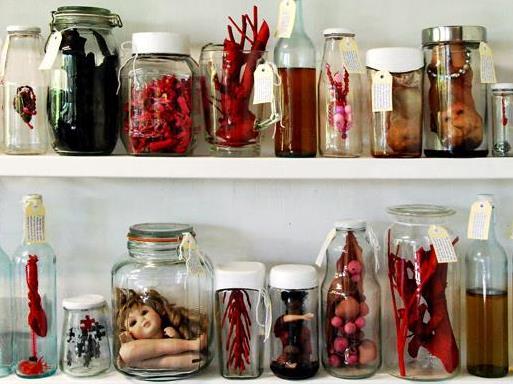Specimen (detail), 2013, found mixed media objects, dimensions variable, image courtesy the artist & NG Art Gallery, Sydney
Art critic Andrew Graham-Dixon once explained that painter Sir Howard Hodgkin ‘does not set out to paint what the world looks like, but what it feels like’. Mai Nguyen-Long’s (b.1970) multidisciplinary practice arguably does the same. Nguyen-Long has directed a lot of thought to interpreting her feelings. This makes her work challenging with its confusion and ambivalence. In empathising with Nguyen-Long’s feelings, one has to imagine them.
Beyogmos is Nguyen-Long’s first solo exhibition at the Wollongong Art Gallery, in collaboration with curator Gina Fairley. This joint project is a significant moment for Nguyen-Long. Fairley has regularly critiqued Nguyen-Long’s work as it progresses in new directions.
In a career spanning 16 years, recurring themes in Nguyen-Long’s practice include post Vietnam War contexts, memory, diaspora communities, religion – and, somewhat controversially – dogs. These themes come together in Nguyen-Long’s attempt to represent her Vietnamese-Australian identity. The exhibition’s title references the challenge of this project, with the phrase ‘beyond the dog cosmos’ modified into Beyogmos.
In Beyogmos, dogs are peripheral, while still proclaiming a significant presence. Nguyen-Long hints at a new openness by connecting rather than dissecting the past. Beyogmos suggests a singular mandate, but it also exposes new ones. This is achieved with a successful contrasting and connecting curatorial strategy.
To this end, Fairley has delved into the artist’s archive and selected some early paintings.Three are from the Innersphere (1998) series and the remainder from the Interface (1999) series. These early paintings seem remarkably fresh and resolved. Their push-and-pull is reminiscent of paintings by Hans Hofmann (1880-1966).

Innersphere (AA16) (1998); courtesy the artist and NG Gallery
Fairley suggests these formative works illuminate patterns of motifs that connect to the creations in Beyogmos. The creator brings together certain selections of the earlier works that constitute, she says ‘a starting place for continued looking’, as opposed to ‘tracking the journey in between’. Fairley emphasises, however, ‘It’s not a survey exhibition’.
In this context of juxtaposition, balance is a necessary requirement. Without being overly reliant on past works, Fairley manages to achieve this. Not by matching dates or disciplinary comparisons, but through contextual connections.
Nguyen-Long claims her work is to locate a peaceful centre. Paradoxically, however, tumult tends to follow her practice. The art works Pho Dog (2006) and The Burning of Godog (2009) both offended sensitivities of the Vietnamese diaspora.
In Pho Dog, controversy emerged over a Republic of Vietnam (South Vietnam) flag. It was accompanied by the Socialist Republic of Vietnam flag. This was considered highly offensive to the post Vietnam War diaspora.
In Beyogmos, the Vietnamese diaspora is offered a melancholic love song. Nguyen-Long exhibits a stop frame animation resembling the work of William Kentridge. She was inspired by the entrepreneur/film-maker/activist Nga Chu (aka Miss Chu). The famous traditional Vietnamese love song Diem Xu (You My Deep Sorrow) is an additional influence. It was written by Vietnamese composer Trinh Cong Son (1939-2001) affectingly known as Vietnam’s Bob Dylan. The singer is Khanh Ly, also famous for her anti-Vietnam War songs. This song resonates strongly with the Vietnamese diaspora. Its intention is neither pro or anti Republic of Vietnam.

Beyogmos stop frame animation; courtesy the artist and NG Gallery
The main pivotal work is Vessel (2013), the only sculpture in Beyogmos. This solitary form portrays a disemboweled dog. Coloured mostly reds and oranges and vivisected, it depicts a violent end. Fourteen protruding pipes represent ribs, accompanied by the remains of an atlas. There are also fragments of a mirror and glass beads. All these elements succeed in creating a stand-alone object.
The most delicate work displayed is the installation Specimen (2013). The 136 glass vessels resemble a specimen laboratory. These vessels are made from discarded bottles and jars. Each contains objects that stir memories of conversations and emotions.
Without a doubt the painting Mis/alignment (2013) is the strongest work. In the top right corner is a floating organ. It crosses through four sections of 44 canvas boards. They resemble Imants Tillers’ established canvas board technique. Yet they have a closer connection to Nguyen-Long’s Pho Dog mirror board installation. The organs could be human or animal; hearts could be joined to brains.

Mis/alignment 2013; courtesy the artist and NG Gallery
Arguably, the strangest work exhibited is the technically raw video The Camellia Vase (2014). Here there are too many ambitious expectations for three minutes and the themes are not fully realised. It begins with a mournful passing of a grandmother and ends with a stubborn rejection of the artist’s mother. Neither the grandmother nor mother is named, which dehumanises the subjects. This seems odd coming from an artist who declares peaceful intentions.
No matter what Nguyen-Long’s purposes are in Beyogmos, feelings always complicate matters. The revelation of so many emotions is confronting and touching and their ambivalence is mystifying. She does this in a way that is seldom expressed and is pure Mai Nguyen-Long. Her collaboration with curator Gina Fairley is largely responsible for these revelations. Perhaps better use of interpretative labels would have significantly informed some of the works.
Rating: 4 out of 5 stars
BeyogmosBy Mai Nguyen-Long
Wollongong City Gallery, Crn Kembla and Burelli Sts
www.wollongongcitygallery.com
1 March – 25 May
The artist will conduct a two day drawing workshop between 24-25 May.
Gina Fairley is Visual Arts Editor at artsHub.





